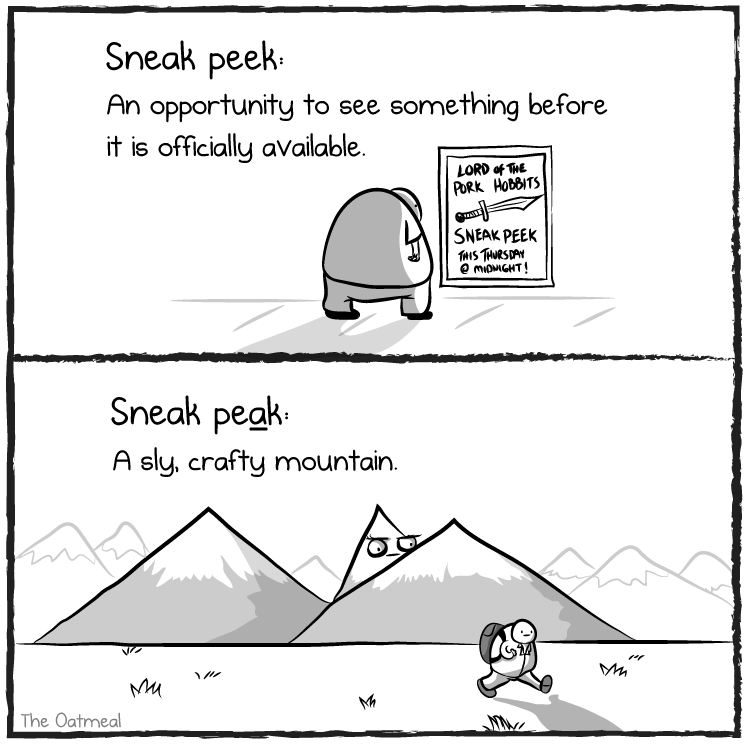 Did you know that PepsiCo makes four times more grammatical errors than Coca-Cola in its LinkedIn posts? And Facebook makes four times more errors than Google?
Did you know that PepsiCo makes four times more grammatical errors than Coca-Cola in its LinkedIn posts? And Facebook makes four times more errors than Google?
Now, consider this: Last year, Coke’s market share topped Pepsi’s by 11 percent, and Google’s second-quarter revenue beat out Facebook’s by nearly $13 billion.
Sure, Pepsi incorrectly using “too” probably wouldn’t sway you to consciously purchase Coke products instead, but on a subconscious level, we often equate sloppy writing with sloppy, careless operations.
Some readers may ignore the errors in your message, and some may never even notice them — but that doesn’t mean you should take your readership for granted by publishing messy content and hoping it works out for you. With all the content your audience has access to these days, it’s easier than ever for readers to abandon your careless copy for higher-quality content.
Don’t let something as simple as lackluster writing or bad grammar ruin your company’s reputation, damage its credibility, or cost you your audience. It might seem daunting (especially if you don’t consider yourself to be a good writer), but to improve your writing, you don’t have to throw out your razor, take a hiatus in the mountains, or trade in your tech for a quill and parchment.
To get started on your path to high-quality content and a stellar reputation in front of investors and your target market, take a look at some of the most commonly misused words to learn how you can get them right in your content:
1. Home vs. Hone
How many times have you heard someone say he needed to “hone in on something”? Some of the most prominent people and publications use this phrase, so it must be correct, right?
Wrong.
“Home” means “to focus attention on,” while “hone” means “to refine.” So the correct way to write the above phrase is “home in on something.” But if this guy wanted to refine a skill, for example, then he’d need to “hone” it.
2. Number vs. Amount
These seem interchangeable — in reality, they each refer to different types of nouns.
“Number” refers to nouns that can be counted, such as pizzas. For example, if I have five pizzas and you have five pizzas, I would write, “We have the same number of pizzas.” Pizzas can be counted and assigned a number.
On the other hand, “amount” refers to mass nouns. Mass nouns are those that can’t be counted, such as “water.” For example, I might say, “Josh has the same amount of water as me.”
It’s important to note that some nouns, such as “water,” can switch between being countable nouns and mass nouns, depending on context. While water itself (like in the example above) can’t be counted, gallons of water can be. In that instance, we would use “number” because those gallons are countable: “Josh has the correct number of gallons of water in his swimming pool.”
3. Peek vs. Peak vs. Pique
A “peek” is a quick look, a “peak” is the highest point, and “pique” usually means “to stimulate.”
Brands that struggle with these definitions offer consumers a “sneak peak” at a new product or service. But as The Oatmeal so cleverly explains, a “sneak peak” is a “sly, crafty mountain.” That’s probably not what you wanted your Facebook post to say.

4. Every Day vs. Everyday
The misuse of these words crops up everywhere. It might not seem like a big deal, but that tiny space changes the meaning quite a bit.
“Every day” means “each day,” while “everyday” means “common.” So you could say, “This is my everyday hairstyle,” or “I wear this hairstyle every day.”
5. Complementary vs. Complimentary
While there’s only a one-letter difference, this mistake could actually cost you some money.
When things are “complementary,” they go well together (like pizza and Netflix — is there a more perfect union?). “Complimentary,” however, means that something is free or that someone is handing out compliments like they’re cookies at a blood drive.
So when you’re sending a client information about service offerings that would go well with her current package, be sure you don’t write that you’re offering “complimentary services” — that means you’re giving away these additional services for free. The correct way to write this is “complementary services.”
6. Good vs. Well
“Good” is the adjective form that describes something, while “well” is the adverb form that describes how something is done.
It’s perfectly acceptable to write “good job” because “good” is an adjective describing the job itself. However, you’d write “a job well done” because “well” is an adverb describing how that job was done.
Here’s another example: “I have good vision” is acceptable because “good” is describing the noun “vision.” However, “I can see well” is correct because “well” is describing the verb “see.”
7. If vs. Whether
These can be tricky, especially because “whether” sounds a little formal, so many people opt for “if” to establish a more conversational tone. But “if” and “whether” have different meanings and are applicable in different types of sentences. I’ll break it down for you:
“If” is used in conditional sentences, which usually discuss hypothetical situations. “Whether” is used when you’re demonstrating that there are two options.
For example, I might say, “If I go to the mall, I’m going to buy a pair of boots.” This is correct because “if” is used in hypothetical situations like this one.
On the other hand, I might say, “I don’t care whether I find a pair of boots at the mall.” “Whether” works in this sentence because there are two possible outcomes. It might not seem like there are two options, but that’s because the second option — “or not” — is implied. With the hidden alternative in place, we’d say, “I don’t care whether or not I find a pair of boots at the mall.”
8. Farther vs. Further
These two seem synonymous, but they are, in fact, used quite differently. “Farther” is used when discussing physical distance, while “further” refers to figurative distance.
For example, “I drove farther than him” is correct because it’s discussing the physical distance that the drivers drove. However, “Let me explain this further” is correct because it’s referring to the figurative distance of describing something in more depth.
9. Affect vs. Effect
“Affect” is the verb form that means “to influence,” while “effect” is the noun form that means “a result.”
For example, I might say, “We were surprised that the cat video affected Katie’s mood so much,” or “The cat video had a strange effect on Katie’s mood.”
There are, however, two exceptions: In psychology, “affect” is a noun when referring to how people express emotion. And “effect” can be used as a verb when you’re saying that something will “effect change.”
As you can see, one tiny letter or one minuscule space can make all the difference in a word’s meaning. While readers might get the gist of what you’re saying, on a subconscious level — or not subconscious for “grammarphiles” like me — they’re judging your brand and deeming it sloppy and careless. And that’s the opposite effect you want to have on your target audience.
To hone your writing and foster a good relationship with your audience, take note of these commonly misused words and make a concerted effort to correct them in your writing. You never know — it could mean the difference between a sale for you and one for your competitor.
Now that you've got an A+ in grammar and word usage, make the content creation process easier by downloading our knowledge management template below!




 Did you know that PepsiCo makes
Did you know that PepsiCo makes 




